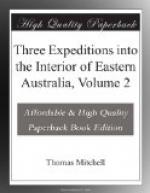(Footnote. This was the only fish caught in the Glenelg notwithstanding the men threw in their lines whenever we encamped on its banks. The weather was too cold for it was evident the river did contain fish from the trellised work which the natives had set across it in the upper parts.)
STORMY WEATHER.
The weather was more moderate today although still showery; and the scenery as we proceeded upwards was very picturesque and full of variety. At sunset we encamped about a mile and a half short of our camp of the 18th and just as the trees were groaning under a heavy squall which obliged us to land on the first spot where sufficient room was left in the thick woods for our tents. This spot happened to be on a steep bit of bank; and in the evening I was called in haste to a new danger. The wind had suddenly changed and blew with great fury filling my tent with sparks from a large fire which burnt before it. I had placed in it according to usual custom our stock of ammunition in a keg; and notwithstanding these precautions its preservation now between the two elements of fire and water was rather doubtful. We contrived however to avert the danger and were no more disturbed during the night except by the storm.
RETURN TO THE DEPOT.
August 22.
The squally weather continued until noon when sunbeams again adorned the river-scenery. We met with no impediment in the current until within about six miles of the depot camp when dead trees in the channel began again to appear; but we passed them all without hindrance and reached Fort O’Hare at two o’clock where we found all well. Mr. Stapylton had set Vulcan to repair the broken chains etc., a ford had been cleared across the stream from the north-east which I named the Crawford; and the cattle being refreshed we were once more in trim to continue the land journey. The height of the water in the river had undergone no change during our absence and was probably about its usual level there although I observed abundant marks of flood in the branches of trees where dry floated matter remained at the height of fifteen feet above the water as it stood then. The rock about this position consisted of limestone apparently similar to that seen on its banks higher up. (See August 15.) It possessed a stalactitic aspect by the infiltration of calcareous matter and in crevices below I found a reddish stalagmite containing grains of sand. Large petrified oyster shells lay loosely about the bank above these cliffs. No natives had approached the depot during our absence and we had indeed reason to believe that the adjacent country contained but few inhabitants.
DIFFERENCE IN LONGITUDE.
During the afternoon I laid down my survey of the estuary of the Glenelg and completed by 10 P.M., not only my plan of it but that of the river also. I found a considerable difference between the result of my survey and the Admiralty charts not only in the longitude but also in the relative position of the two capes with respect to Mount Gambier a solitary hill easily recognised.*




